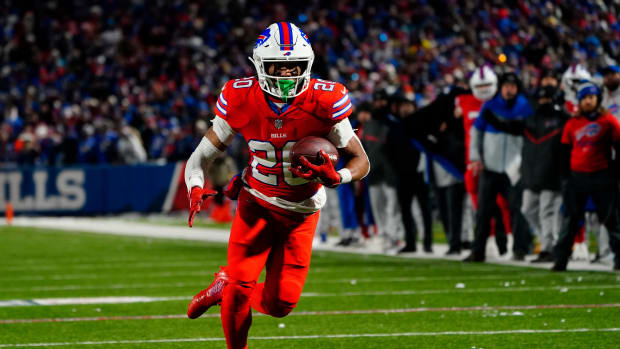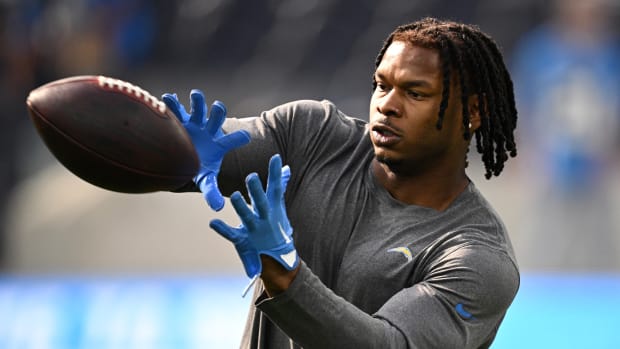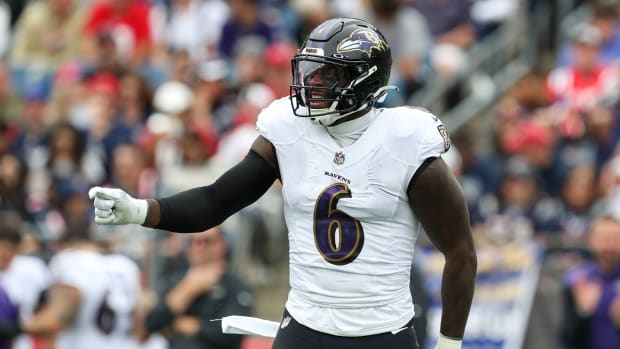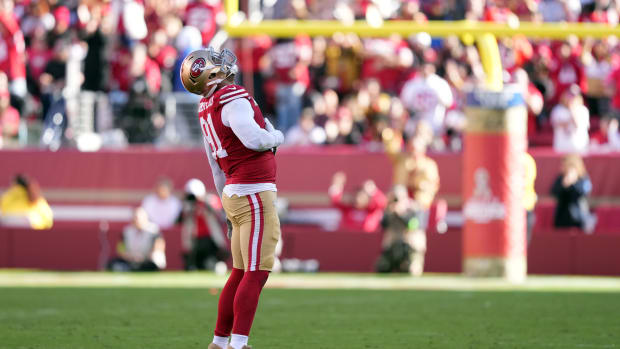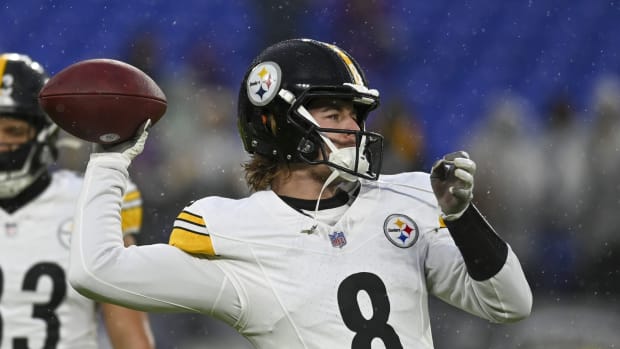Fixing the QBs: In a new system, Philip Rivers can set things right
It's been a confusing couple of years for the Chargers' Philip Rivers. (Christian Petersen/Getty Images)
From 2006 through 2010, San Diego Chargers quarterback Philip Rivers was unquestionably one of the best at his position in the NFL. The Chargers went 14-2 in 2006 -- his first year as the team's starter after the departure of Drew Brees -- and the team never had a losing season through that five year stretch. Despite his status as one of the league's more prolific deep-ball throwers (he led the NFL in yards per attempt every season from 2008 through 2010), he was also one of the game's more efficient passers. He finished in the top three among qualifying quarterbacks in Football Outsiders' opponent-adjusted metrics in those three seasons, and there was little doubt Rivers would continue on a favorable track as long as he remained healthy.
Except, of course, that he didn't remain on that track. He had a fairly miraculous 2011 season in which he maintained much of his efficiency despite a lot of roster churn, but Rivers' play fell off, making victims of general manager A.J. Smith and head coach Norv Turner, both of whom got the axe following the 2012 season. But Rivers' decline was part and parcel of the failures of both Turner and Smith. First, Smith lost his fastball as a personnel executive in a hurry, and that led to a steep decline in San Diego's offensive line and receiver corps. Second, Turner's long-touted knack for developing offenses and maximizing quarterbacks seemed to take a serious hit, because everything was declining around him.
In 2012, Rivers was one of two NFL quarterbacks to play in 100 percent of his team's snaps (Andrew Luck was the other), and it's pretty certain that he'd like a lot of those snaps back. He declined precipitously in efficiency, and suffered the results of many more questionable throws. Everyone had an answer for what ailed Rivers. ESPN analyst Ron Jaworski, who ranked Rivers 17th in his 2013 QB Countdown, had this to say:
“Last season Rivers was sacked 49 times, significantly more than any other season in his seven years as the Chargers’ starter. His competitive nature pushed him to compensate, to try to make plays he was not capable of making. As a result, Rivers led the NFL with eight third-down interceptions.
“Rivers is an orchestrator, not an improviser or a playmaker. There’s a new coaching staff in San Diego, but the offensive line remains, at best, a work in progress. Rivers must play with more discipline. He must let the offense work or not work. He can’t force it. I would expect a better, more consistent Rivers in 2013.”
Through Rivers has always taken heat for his unorthodox delivery, Greg Cosell of NFL Films and ESPN's NFL Matchup (and the producer of Jaworski's QB Countdown) doesn't see that as the problem.
TROTTER: Calling Qualcomm Stadium a dump is an insult to garbage heaps
Motion Creates Emotion
"Well, it's his throwing motion, and this has been well-documented," Cosell told me. "He's not an over-the-top thrower, and he's not even really a three-quarters thrower. He's sort of a shot-put thrower, and I remember that when he came out of college, it really bothered me. I'm a purist, but the more you watched him play -- I mean, he was very good when he became a starter, and you resigned yourself to the way he throws. You can't say that he hasn't played as well the last two years because of his motion. He has a very quick release, and he doesn't have a gun, but you could say through most of his career that he's had better-than-average arm strength, and could make every throw."
So, why has Rivers regressed? At the heart of the problem seems to be a disconnect between what Rivers was asked to do, and what he's actually capable of.
"Really, just for him to do what the offense asks him to do," McCoy told the NFL Network in July of his work with Rivers. "Don't try to do too much. Just trust the system, and he'll be fine. After spending the last couple of months with him, his arm's a lot stronger than people think it is. If he anticipates throws more quickly, it's a big play."
Rivers' new offensive coordinator is former Arizona Cardinals head coach Ken Whisenhunt, and both McCoy and Whisenhunt have engineered impressive quarterback fixes in their careers. The work McCoy did with Tim Tebow in 2011 when he was Denver's offensive coordinator has been well-documented, but the way to Rivers' professional reclamation could be far more similar to what Whisenhunt did with Kurt Warner in the Valley of the Sun from 2007 through 2009. Through the early and middle parts of his NFL career, Warner (much like Rivers) was asked to stand in the pocket, often behind iffy protection, and wait the time it took to take shots downfield. As a result, his sack percentage was never lower than 5.4 (with the St. Louis Rams in 2000), and it was a ghastly 12.3 percent (39 sacks in 277 attempts) for the New York Giants in 2005. From 2007 through his last season of 2009, Warner's sack rates were 4.2%, 4.2%, and 4.5%.
When Whisenhunt and Warner started working together seriously, Warner took far more three- and five-step drops in more precise timing routes. Yes, it helped that Warner had Larry Fitzgerald at his absolute peak, but as we've seen in the last few years, even Fitzgerald needs an actual quarterback throwing the ball to him. Warner was not mobile by any means, but Whisenhunt and offensive coordinator Todd Haley minimized the risks inherent in that liability by playing to Warner's strengths -- his anticipation, his ability to make accurate throws to any part of the field, and his knack for taking defenses apart pre-snap. When asked to move, Warner, like Rivers, lost what made him great.
BENOIT: Rivers must cut down on turnovers for Bolts
"I think a couple of things have happened over the last couple of years," Cosell said of Rivers' decline. "First, he's human. His offensive line has been a mess, and for him, this is not good. He has started to anticipate pressure, and he's been too quick to move at times. And, he's not a mover. As soon as he moves [to leave the pocket], his efficiency drops dramatically. He switches from what he is to what he's not, and you get a greater likelihood of negative results. He loses clarity on the move, and he's not a high-level athlete. Certain guys, like Aaron Rodgers and Russell Wilson, maintain excellent downfield focus when they move, and Rivers does not."
This will be an important adjustment for Rivers, because it could easily be argued that the era of the "stand there and throw it" quarterback is dwindling, if not gone altogether.
Walking the Dinosaur
As defenses become more complex and the players implementing the schemes get faster and stronger, functional quarterback movement is more important than ever. In the 2013 version of the NFL, the best throwers, regardless of pure physical tools, are the ones who can constantly re-set under pressure, keep their eyes downfield, and maintain the integrity of the play. Rivers at his best was a player devoted to the integrity of the play at all costs -- but in his case, the costs have been exorbitant.
"At the end of the day, you're dealing with a pure pocket quarterback," Cosell said of Rivers. "His strength, much like Peyton Manning's, is that he's always been incredibly smart and incredibly aware -- very good pre-snap and post-snap. Very few plays happen late in the down; that is to say that the majority of his plays happen within the timing of the called play. He was so good at knowing where to go with the football, and that minimized the bodies around him. So, he ended up being a quarterback who could function as a pure pocket passer in a league where movement has become more important."
By "movement," we don't mean to say running around and throwing the ball, RGIII-style. That's not always required. Tom Brady is an excellent example of a quarterback who is not mobile in that sense, but has an incredible awareness of what's around him, how long he has before things break down, what his receivers are doing, and when he must either pull the trigger or admit defeat. You could say the same about most any highly-productive quarterback without amazing foot speed and with historically low interception rates.
In Rivers' case, it could be argued that the attrition of protection around him has caused his internal clock to malfunction far too often. He now senses pressure where there is none, causing him to make mistakes under pressure when said pressure doesn't yet exist. Even at his best, Rivers was almost in the Drew Bledsoe mold -- the old-school quarterback with estimable toughness in the pocket and the ability to make long-distance throws even though he knew he was about to get the tar beaten out of him.
One example of this was the first of two interceptions he threw in the Chargers' 34-24 Week 10 loss to the Tampa Bay Buccaneers in 2012. San Diego had third-and-4 at the Tampa Bay 23-yard line with 13:42 left in the game, and Tampa Bay up, 24-21.
Tampa Bay shows a dual "A"-gap blitz pre-snap against San Diego's 'twins right' route concept. The illusion of pressure will change the play.
The Bucs drop all but four defenders into coverage (Ronde Barber comes from the left on a CB blitz that is picked up by the back), but Rivers acts as if there's more pressure. He's looking to bail already. Malcom Floyd runs an out-and-up from the top of twins, while Eddie Royal hits a shorter out route to provide an outlet underneath.
From the overhead view, we can see that Rivers has an open man to his left because the defender has fallen down, but doesn't see it because he's already committed to roll right. As Floyd drives up to the end zone, Royal cuts to the sideline.
Rivers actually has an open receiver when Royal cuts to a comeback, but he does not commit to the throw.
Rivers waits until several Tampa Bay defenders have converged to the sideline, and instead of throwing the ball away, he tries to hit Royal. Leonard Johnson gratefully accepts the resulting easy pick for an 83-yard touchdown
"In hindsight, not only do I wish I was throwing it over his head, I probably shouldn't have thrown the ball, period," Rivers said after the game. "Field goal ties it up. Quick decisions, and I made the wrong one there. It's a humbling game because it shows how one play, essentially one play, can ruin a game. We killed ourselves on the interception for touchdown. We were rolling pretty good most of the game."
Rivers' new coach doesn't see this kind of silliness as part of his paradigm.
"This is a case where ... it's the next best thing," McCoy said of this play on the NFL Network. "If it's not there, throw it away, or just run out of bounds. Don't try to make something that's not there -- that's just a poor decision."
On July 31st, McCoy outlined how things will be different for Rivers from here on out.
"Philip is a big reason why, as a staff, you are so excited because ... everything starts at the quarterback and when you have someone like him, he’s bought in from day one. He knew we were changing completely. I think it is good for him also because it kind of re-energizes him. He’s been in the same system for a long time and had a ton of success. But now it comes down to, he can’t just walk out there every day and just say he knows everything. He’s got to think about things. Before he walked out here today, [we] were sitting in Ken’s office talking about something and Philip kind of walked by and he had that look on his face like he had a question about -- 'Can we change this?' And Ken actually already changed it on the script, so it’s back to being a little kid again. He’s got to come out here every day and check scripts. He’s got to make sure he leaves here, he studies. We had two minute drill for the first time. He had gone back and watched how the defense played two-minute the whole entire time in the offseason when we had practice out here. So it’s going to re-energize him. He’s going to have a great year. We’re really excited for what he’s done. He’s the face of the franchise and we’re very happy to have him."
All indications point to Rivers playing in a quicker passing game with more applied thought, which is a good start. His offensive line is still a problem, but Warner's wasn't anything to sing about in Arizona, and he adapted to make that line look better. He doesn't have anyone with Fitzgerald's talent, but last time we checked, that Antonio Gates guy is still pretty good. Rivers still has enough talent to be an impactful player in the NFL, and he may finally have people willing and able to get him back on the path. Step one for him will be to drop the gunslinger act and become more sure with his targets.
Fixing the QBs series: Can Matthew Stafford overcome a lack of mechanics?
Fixing the QBs series: Josh Freeman, and the lag between potential and greatness
Fixing the QBs series: Can Jay Cutler develop the consistency that his new coach demands?







































